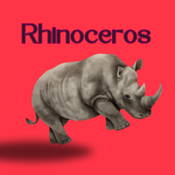
In a provincial French village, Berenger and his friend Jean meet at a local cafe for a Sunday afternoon drink. Berenger is unkempt, admitting that he drinks too much and often feels fearful. Jean, well-manicured and poised, tries to help his friend. But their meeting is disrupted by a rhinoceros thundering through town, drawing onlookers and speculation about how the pachyderm--whether with one or two horns, whether an Asiatic or African rhinoceros--got there. As time goes on, more rhinoceroses appear. Berenger realizes that the rhinoceroses are their neighbors, coworkers, and friends; some villagers are skeptical of the phenomenon, while others feel that they have no choice but to join them. As Berenger watches his world descend into the chaos of the stampede, he is faced with the moral dilemma of his own identity in the face of societal decay. Hailed as an early example of Theatre of the Absurd, Eugene Ionesco’s Rhinoceros is an allegory that warns of the dangers of nationalistic fervor, mob mentality, and the rise of destructive political forces.
Rhinoceros guide sections